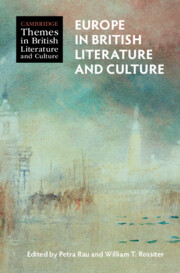Book contents
- Europe in British Literature and Culture
- Cambridge Themes in British Literature and Culture
- Europe in British Literature and Culture
- Copyright page
- Contents
- Illustrations
- Contributors
- General Editor’s Preface
- Acknowledgements
- Introduction
- Part I Zones of Influence
- Part II Pan-European Moods and Movements
- Part III Cultural Transfers
- Chapter 12 Early Modern Print Technologies
- Chapter 13 Diplomacy
- Chapter 14 Grand Tours and Sentimental Journeys
- Chapter 15 Folk and Fairy Tales
- Chapter 16 Translation
- Chapter 17 More or Less English
- Chapter 18 Holocaust Education and Commemoration in Britain
- Chapter 19 Critical and Literary Theory
- Chapter 20 Culinary Longings
- Part IV Anxious Neighbourhoods, Uncertain Futures
- Index
Chapter 15 - Folk and Fairy Tales
from Part III - Cultural Transfers
Published online by Cambridge University Press: 06 June 2024
- Europe in British Literature and Culture
- Cambridge Themes in British Literature and Culture
- Europe in British Literature and Culture
- Copyright page
- Contents
- Illustrations
- Contributors
- General Editor’s Preface
- Acknowledgements
- Introduction
- Part I Zones of Influence
- Part II Pan-European Moods and Movements
- Part III Cultural Transfers
- Chapter 12 Early Modern Print Technologies
- Chapter 13 Diplomacy
- Chapter 14 Grand Tours and Sentimental Journeys
- Chapter 15 Folk and Fairy Tales
- Chapter 16 Translation
- Chapter 17 More or Less English
- Chapter 18 Holocaust Education and Commemoration in Britain
- Chapter 19 Critical and Literary Theory
- Chapter 20 Culinary Longings
- Part IV Anxious Neighbourhoods, Uncertain Futures
- Index
Summary
This chapter traces the emergence of the fairy tale as a generically defined form in Britain in the course of the eighteenth and nineteenth centuries, and argues that this process of generic consolidation was the product of a series of fruitful creative and commercial interchanges of narrative tradition with the continent of Europe. To make this argument, the chapter focuses upon the importance, for British approaches to the fairy tale, of the seventeenth- and eighteenth-century French vogues for literary fairy tales, and the revolution in approaches to traditional storytelling spearheaded in nineteenth-century Germany. It is also proposed that the work of the Scottish fairy-tale collector and anthologist Andrew Lang in consolidating and popularizing these continental traditions at the end of the nineteenth century was instrumental in giving shape to British ideas about the fairy tale at the cusp of the twentieth century. Writers, translators, and collectors considered in this chapter include Marie Catherine d’Aulnoy, Charles Perrault, Jean-Marie Leprince de Beaumont, Jacob Grimm, Wilhelm Grimm, and Robert Samber.
Keywords
- Type
- Chapter
- Information
- Europe in British Literature and Culture , pp. 244 - 258Publisher: Cambridge University PressPrint publication year: 2024

